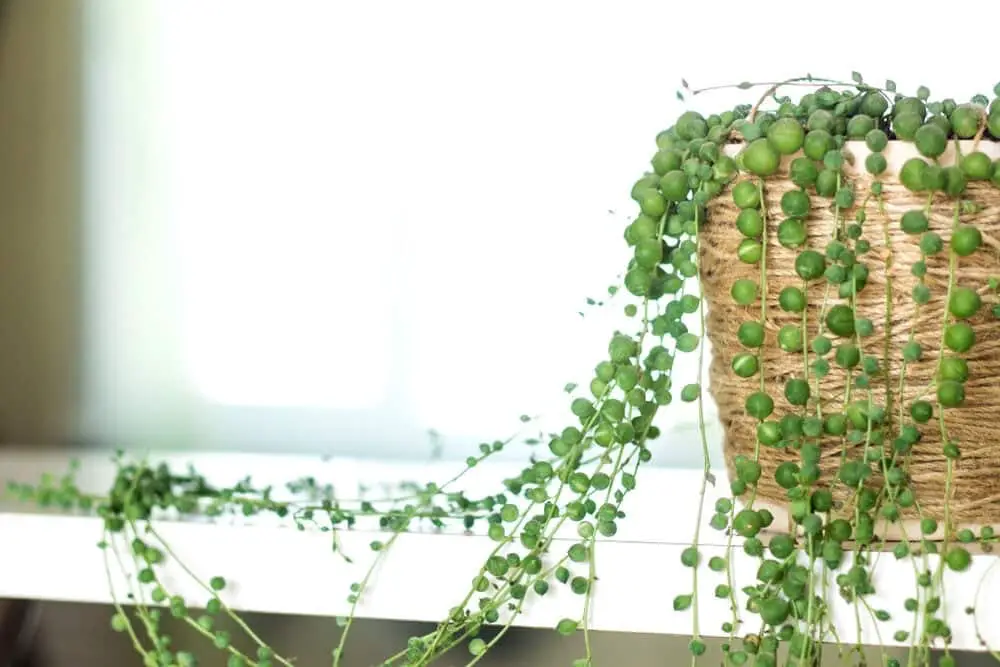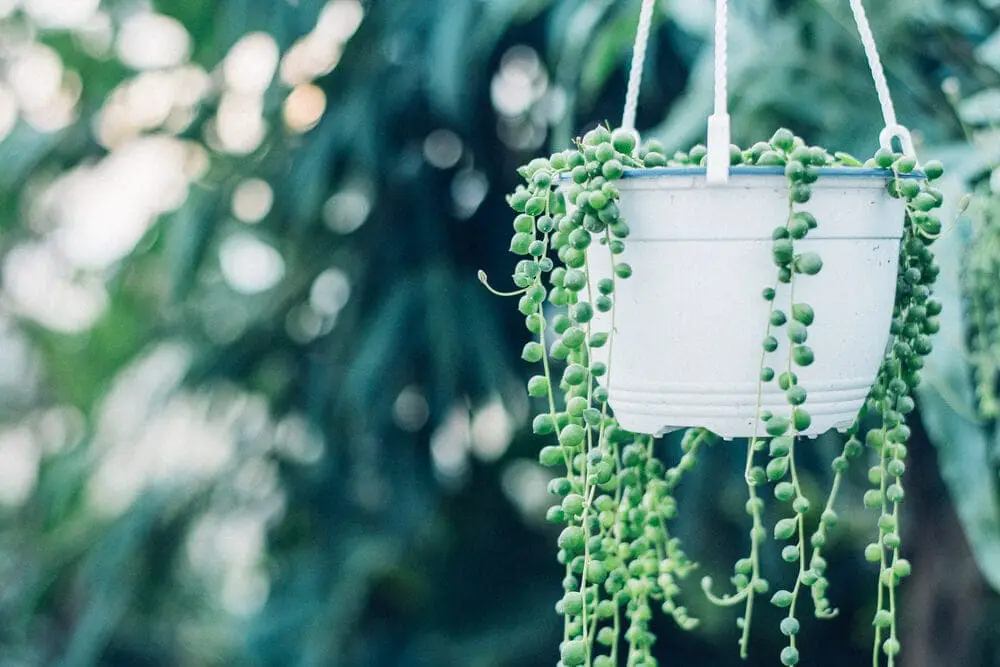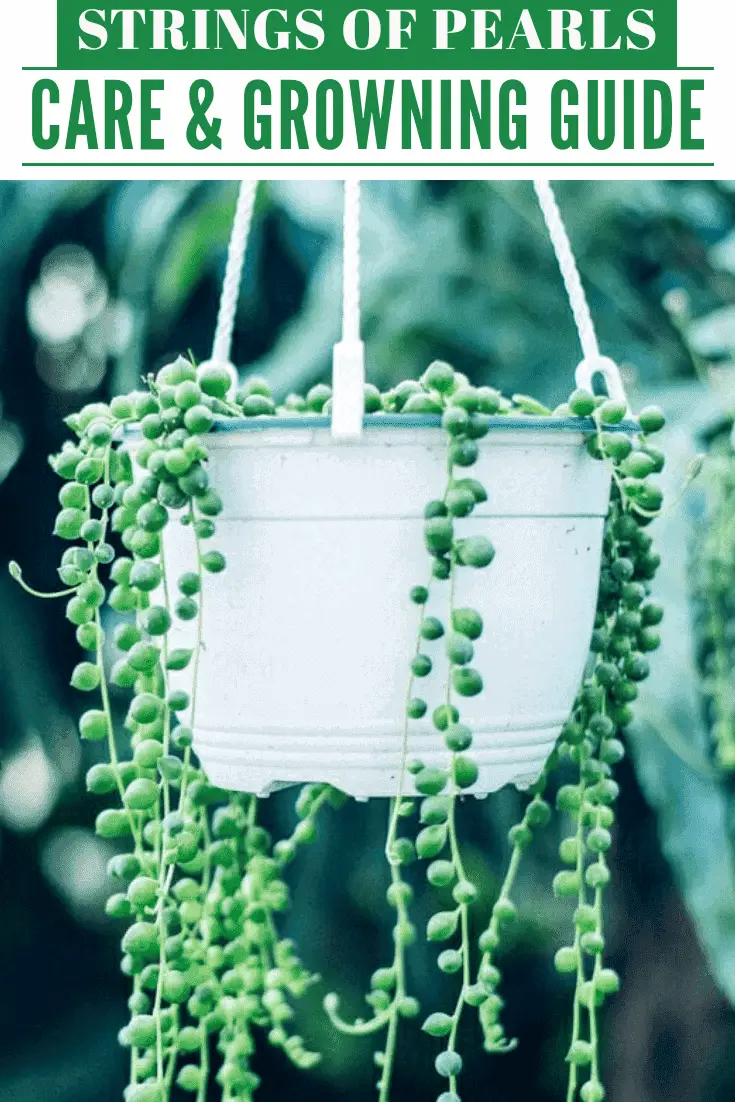Do you want a unique hanging basket flower? Then look no farther than the String of Pearls.
This plant looks like green peas hanging over the rim of the pot. The pot can also be set on a window sill. Everyone will be talking about your unique plant. It is also easy to grow indoors.
String of Pearls Care & Growing Guide
1. Light Requirement
The String of Pearls grows best in bright light, including sunlight. It does best when it in is or near a window that faces south or west. If you have limited natural light, you can use a fluorescent light. Put the plant 6 to 12 inches under the light for 12 to 16 hours each day.
2. Water
One important thing to remember when watering your String of Pearls plant is that in a pot with no drainage holes make sure that you do not overwater it. This is a plant that does not need to be watered frequently. The leaves retain moisture quite well.
You will only need to water them one or two times a month. In the winter, watering should be reduced to once a month, because during the winter they are not actively growing and do not need as much water. Before watering, let the soil become dry.
3. Climate
This plant does best in hardiness zones 9 to 12.
4. Soil
The best soil in which to plant your String of Pearls is a well-draining succulent or cactus potting mix. This type of soil is different from your houseplant soil. This potting mix will facilitate drainage faster because of the sand and perlite that is added to the mixture. This type of plant must have plenty of drainage through the drainage hole at the bottom of the pot.
5. Temperature
The String of Pearls is not picky about humidity. They usually tolerate a range of indoor temperatures from 55 to 85 degrees Fahrenheit. In the summer, the plant can live outdoors. During the peak heat hours, it needs to be in a shaded area.
This is a plant that does not like the cold. If you put it outdoors when the temperatures are below 50 degrees Fahrenheit, it can start to drop leaves.

6. Repotting
The String of Pearls should be repotted when they become root-bound. When you repot them, you are helping to prolong the health of your plant. If you are repotting to start new growths, remove four inches from the plant, cutting in between the pea-like leaves. This should be done during the time they are actively growing, spring until summer. The rooting can take several months.
7. Speed of Growth
Although it does not state the speed of growth, it does state that the plant takes root fairly quickly. If you try to start a String of Pearls from seeds, it will take a long time before it looks like an adult plant. The fasted way to get a new plant is to use cuttings.
8. Height and Spread
The String of Pearls can grow two to three feet long if you let their stems grow downward uninterrupted.
9. Flowers
This plant produces ½ inch compound flowers. They are similar looking to a daisy and are conical in shape. The flower is white with long red stamens and bright yellow antlers. They will last about a month. The scent of the flower is similar to cinnamon.
10. Trimming
They do not need to be trimmed but you can give them a bit of grooming. Any stems with leaves that do not look healthy, you can cut them off. The ends of the stems can also be trimmed if they look scraggly.
Is String of Pearls Poisonous?
If ingested, this plant can be toxic to humans and pets. It is advisable that when working with this plant that you wear gloves to prevent accidental ingestion of the plant from being on your hands.

Can String of Pearls grow in Water?
You can propagate String of Pearls by putting root cuttings in water. They will root quickly, giving you new growth.
How to get String of Pearls to Flower?
The String of Pearls can bloom but some do not. In the resting season during winter, cut back on the water a little to help promote blooming in the spring. Keep the plant cool in the winter by keeping it away from the heat registers and put them on a window sill.
Keep reading: Monstera Adansonii Care & Growing Guide
Common String of Pearls Plant Diseases
The String of Pearls is prone to several diseases, including:
- Root rot—this can happen if you water them too frequently.
- Pests—generally they are not vulnerable to pests but can sometimes be infested with aphids, fungus, and mealy bugs. You can use a cotton ball dipped in 70% rubbing alcohol and rub it on the leaves.
Also read:
Conclusion
- If you have a pot with no drainage holes, add a layer of perlite or small pebbles in the bottom of the pot before putting in the potting mixture. This layer of drainage will keep the roots from sitting in wet soil.
- Remember to water them as directed because if you wait too long to water them, it can affect the leaves. The leaves can wilt or shrivel/flatten if the soil becomes too dry. Good watering can revive the plant as long as it has not been too dry for too long.
- They do not need to be fertilized but during the active growing season, which is spring/summer, you can use a houseplant fertilizer that has been diluted.
- If you want them to appear fuller, stick the ends of the stems back into the soil so it makes a little loop.
- To propagate String of Pearls, take three to four-inch stem tip cuttings, making sure to remove any leaves from the bottom and put in the potting mixture.
- To help encourage flowering in the spring, move the plant to a cooler area of the house during the winter months. The best temperature for this process is around 60 degrees Fahrenheit.
- Do not let the String of Pearls grow long enough to touch the floor, especially if you have children or pets because they are very toxic if ingested. Keep them out of reach of children and pets.

Victoria is the owner and main author of hobby plants. She loves spending her free time in her garden planting and taking care of her plants. Victoria hopes you enjoy the content here!
![How To Propagate A String Of Hearts? [BEGINNER'S GUIDE] How To Propagate A String Of Hearts? [BEGINNER'S GUIDE]](https://www.hobbyplants.com/wp-content/uploads/2022/07/how-to-propagate-string-of-hearts-300x158.jpg)
![Mother Of Thousands Plant [Complete Plant Care Guide] Mother Of Thousands Plant [Complete Plant Care Guide]](https://www.hobbyplants.com/wp-content/uploads/2022/07/mother-of-thousands-plant-300x158.jpg)
![How Often Should You Water Pothos? [Complete Care Guide] How Often Should You Water Pothos? [Complete Care Guide]](https://www.hobbyplants.com/wp-content/uploads/2022/07/how-often-to-water-pothos-300x158.jpg)
![Can Snake Plants Live Outside? [COMPLETE CARE GUIDE] Can Snake Plants Live Outside? [COMPLETE CARE GUIDE]](https://www.hobbyplants.com/wp-content/uploads/2022/08/can-snake-plants-live-outside-300x158.jpg)
![Majesty Palm Plant Care: [Complete Beginner's Guide] Majesty Palm Plant Care: [Complete Beginner's Guide]](https://www.hobbyplants.com/wp-content/uploads/2022/08/majesty-palm-care-300x158.jpg)
![Exotic Angel Plant Care: [Complete Beginner's Guide] Exotic Angel Plant Care: [Complete Beginner's Guide]](https://www.hobbyplants.com/wp-content/uploads/2022/08/exotic-angel-plant-care-300x158.jpg)
![Do Coleus Like Sun Or Shade: [Complete Care Guide] Do Coleus Like Sun Or Shade: [Complete Care Guide]](https://www.hobbyplants.com/wp-content/uploads/2022/08/coleus-sun-or-shade-300x158.jpg)
![Snow White Waffle Plant: [Complete Care Guide] Snow White Waffle Plant: [Complete Care Guide]](https://www.hobbyplants.com/wp-content/uploads/2022/08/snow-white-waffle-plant-300x158.jpg)
![Waffle Plant Care: [Complete Beginner's Guide] Waffle Plant Care: [Complete Beginner's Guide]](https://www.hobbyplants.com/wp-content/uploads/2022/08/waffle-plant-300x158.jpg)
![Bird Of Paradise Plant Care: [Complete Beginner's Guide] Bird Of Paradise Plant Care: [Complete Beginner's Guide]](https://www.hobbyplants.com/wp-content/uploads/2022/08/bird-of-paradise-plant-300x158.jpg)
![Purple Passion Plant Care: [Complete Beginner's Guide] Purple Passion Plant Care: [Complete Beginner's Guide]](https://www.hobbyplants.com/wp-content/uploads/2022/08/purple-passion-plant-care-300x158.jpg)
![China Doll Plant Care: [Complete Beginner's Guide] China Doll Plant Care: [Complete Beginner's Guide]](https://www.hobbyplants.com/wp-content/uploads/2022/09/china-doll-plant-care-300x158.jpg)